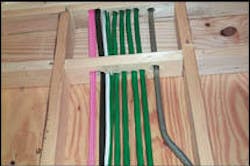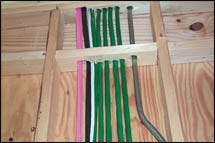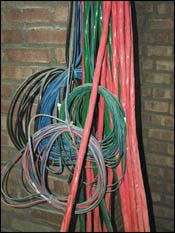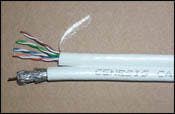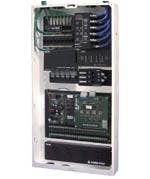Keys to succeeding in residential cabling
Don't just settle for a generic installation. Give the owner some lifestyle options.
The residential structured cabling market is starting to grow very rapidly, but still suffers from a lack of consumer awareness of its features and benefits. While builders have been reluctant to invest in new technologies, since they add to the cost of a house or housing development, there are many ways in which you can capitalize on this potential sleeping giant by understanding how to pitch the benefits of both basic and custom installations.
BICSI will publish a residential methods manual this fall, which will be widely disseminated and will help raise both consumer and builder awareness. After all, Parks Associates (www.parksassociates.com) forecasts that by 2004, more than half of new homes built will include a structured wiring system, resulting in a market whose size will surpass today's commercial voice and data wiring market.
The pre- and re-wire market
There are two distinct markets: pre-wire for new construction, and re-wire for existing construction (where a home office or a home theater needs to be established.)
A pre-wire to accommodate several telephones and TVs can cost a homeowner less than $500. This approach provides a basic system, which fixes the locations of telephones and television sets in the house and does not have a distribution cabinet to facilitate future upgrades. Including a distribution cabinet increases the cost to $1,000. But adding additional information outlets at a later date is cost-prohibitive because of the high labor content required to route cables through attics and crawl spaces, and then fishing them through a wall to get to an outlet location.
The proper pre-wire approach is to utilize a centrally-located distribution cabinet with home run cables running from it to information outlets located in every room. Two information outlets are recommended for the family room, den and master bedroom, with the other rooms getting at least one. Thus, a small home may have 8 to 12 outlets, while a larger home may have several dozen.
The cost to the homeowner for this type of pre-wire ranges from $2,000 to $6,000 depending on the number of outlets wired and the types of modules installed in the cabinet. These modules may include a security panel, connection to a telephone key system, amplified cable television splitters, data hubs, an Internet router, and connections to audio systems, satellite receivers, DVD players and video surveillance cameras.
Re-wire is a different scenario altogether. Creativity, skill and specialized tools are needed to install the wiring necessary for a home theater or a home office in an existing house.
You'll need to determine the best routing for the various cable needs to minimize opening up walls and the subsequent replastering and repainting operations. (The Training Department [www.training department.com] in Tucson, AZ has developed a videotape that shows how to re-wire three different houses-Victorian, contemporary and slab/cinderblock construction.) It can easily cost $2,000 to re-wire one room with several information outlets, due to the high labor content.
A system that works
A good universal solution is to follow the recommendations of the TIA-570-A standard, which will provide a residential structured cabling system meeting the requirements of the vast majority of homeowners. But whenever possible, you should consult the homeowner to determine his or her lifestyle requirements. This will ensure that your wiring systems support the homeowner's whole-house audio, lighting automation, security requirements and other home management needs.
Work with the builder to develop a checklist that shows the basic structured cabling system being offered, giving the homeowner a choice of series of options. These may include additional information outlets, optional modules for the cabinet, and a separate wiring infrastructure for audio, security and automation.
It is not unusual for a homeowner to choose a number of options resulting in a $10,000 wiring package. For a $500,000 home, this only adds 2% to the purchase price and it will be very easy for the homeowner to get back more than that at resale time. Similarly, a $2,500 structured cable system adds 2% to the price of a $125,000 home.
High-end system integrators do a great job of making sure that all possible homeowner needs are met. For example, AllSmart Solutions (www.allsmartsolutions.com) in Libertyville, IL offers a home theater with surround-sound and automated lighting, a video system providing access over the Internet to surveillance cameras, whole-house lighting control, appliance control (such as an automated coffee pot), remote-access zoned environmental controls, a comprehensive security system, a telephone system that can be used as an intercom and can control door access, and whole-house audio with individual room volume controls.
Additional lifestyle options include driveway sensors, motion-detecting flood lamps, automated drapes, pet doors and feeders, medical diagnostic monitoring, a wireless LAN, Web cameras and voice telephony over the Internet protocol, and whole-house surge protection. In certain cases, stand-by power generators are also offered.
Smart room
The company also recommends a "smart room" in the house, which is the residential equivalent of a commercial telecommunications room. If this is not available, AllSmart will offer a large, self-contained and freestanding cabinet where all active and passive equipment for voice, video, data, audio, security and home automation are centrally located and interconnected.
Three different groups of installers can do the wiring. High-end custom homes typically retain the services of a CEDIA-type system integrator. These custom electronics designers and installers know how to design a home theater or a home office and provide a turnkey service. They can do the wiring, install the speakers, set up the audio/video equipment, program home automation cycles and integrate various standalone systems to work together. They can also provide long-term system maintenance and upgrades. The photo on page 25 shows a custom pre-wire that AllSmart is doing in a residence, which includes dual Cat 5e and RG-6 cables, multimedia cables containing two Cat 5e and two RG-6, and high-end sound cables with a Cat 5e to control programming.
A security dealer/installer can do both pre-wire and re-wire projects because of experience in installing cables to difficult locations. The photo above shows some of the re-wiring done in an existing residence by Keyth Security (www. keyth.com) of Highland Park, IL, with various cables coiled in the basement awaiting a cabinet installation. Keyth installed the cabling and residential cabinets, and worked very closely with Audio Video Designs by Gus (www.audiovideodesignsbygus.com) of Indianapolis, which installed the home theater and audio distribution network.
This home required three dozen information outlets and utilized multimedia cable consisting of two Cat 5e and two RG-6 (and multimode fiber-to-the-home theater and home office) to each outlet for a Grade 2 wiring system. Separate sound cables fed the audio network, while coax was used for surveillance video cameras.
Electricians are rapidly entering the pre-wire structured cabling market, primarily in newly developed communities. They can save time and money by installing both the high- and low-voltage cables. Builders can offer a basic structured wiring package, which can be enhanced with options during the selection process. Inland Electric (www.inlandelectric.com) of Shore wood, IL, for example, does pre-wiring for several large national builders. The company primarily uses dual cables containing a Cat 5e and RG-6 under one jacket, resulting in a cost-effective Grade 1 wiring system.
Cabinet choices
All residential cabinets tend to be 14.5 inches wide, so they can be recessed between wall studs on 16-inch centers. Typical cabinet heights range from 8 to 10 inches for condos, to 14 to 28 inches for typical homes, and up to 40 inches for large homes.
A minimum requirement in each cabinet is a telephone connecting block for terminating the twisted pair, and a passive cable splitter for the coax. Room should be left for upgrade components, including patch panels for the voice and data lines, amplified splitters for cable, lighting controls, audio distribution panel, security panel, home automation components, and data hubs and routers.
For large homes, a stand-alone cabinet or rack can be used if there is room for a dedicated telecommunications facility. To meet the requirements of TIA-570A, every structured cabling system needs to have a distribution device, or cabinet. It should be centrally located and be as close as possible to the entry and demarcation points of the telephone and cable television service providers.
In no case can the furthest outlet be located more than 492 feet from the demarcation point. The cabinet should be properly grounded and be within 5 feet from a duplex power outlet.
Cable options
Although individual Cat 5e and RG-6 cables will service the various Grade 1 or Grade 2 outlet configurations, specifically designed dual- and quad-multimedia cables speed installation time (since two or four cables can be pulled at the same time) and minimize termination time (since all ends are readily identifiable).
The dual cable, consisting of one Cat 5e and one RG-6 under a single jacket, was designed to facilitate Grade 1 wiring. It is important that the manufacturer test the Cat 5e and RG-6 cables both before and after the bundling and jacketing processes to check for any electrical performance degradation.
It is also very important that the installer test all cable runs from the cabinet to the information outlets at the completion of the pre-wire. Once the drywall is installed, it is very difficult and expensive to replace a marginal cable run. A basic test consists of continuity and wire map to T-568A on all four pairs of the Cat 5e, and continuity of the coax's inner and outer conductors.
New career path?
Residential structured cabling is slated to grow very rapidly over the next 3 to 5 years. It is likely that the growth will be so rapid that we will quickly use up the pool of qualified installers. Currently, BICSI, NECA and cable and cabinet manufacturers are expending a lot of effort on training low-voltage installers and electricians on residential structured cable installation, termination and testing techniques. Needless to say, this could be an excellent career move for many installers.
John Pryma, PE and RCDD LAN specialist, is vice president and general manager for Genesis Cable Systems' Structured Cable Division, Pleasant Prairie, WI (www.genesiscable.com).
